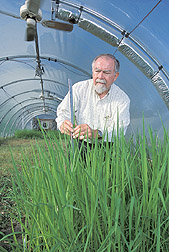Leading the Way in CO2 Research |
|
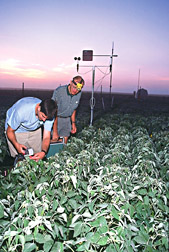 While visiting the ARS Photosynthetic Research Unit in Urbana, Illinois, soil scientist Bruce Kimball (right) assists postdoctoral researcher Carl Bernacchi as he uses a portable photosynthesis analyzer on soybean plants. (K10044-1) |
Carbon dioxide. CO2.
Some think of the gas in positive terms, such as making plants grow or trading carbon credits. Others think that its rising levels in the atmosphere may be harming the environment. The Agricultural Research Service has scientists stationed around the country to study CO2 and its effects on agricultural systems—particularly, how it will affect plants in the future and how we can capture it more effectively in agriculture. This article provides updates on somse of these studies. (See also "Preparing Agriculture for a Changing World," Agricultural Research, July 1997, p. 4.) Are Western Rangelands the Missing Sink? Reports from a CO2-monitoring network across western rangelands show that, at the very least, rangelands seem to be a substantial carbon sink, or storage reservoir, helping slow the buildup of CO2 in the atmosphere. |
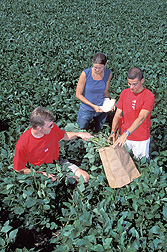 To determine the effect of elevated CO2 on plant growth, University of Illinois students harvest aboveground growth of soybean plants. (K10050-2) |
The network partially has its roots in a mystery announced by global modelers in the 1980s: They couldn't account for 2 billion tons of carbon emitted annually in CO2 from burning fossil fuel, deforestation, and other sources. It had to be stored somewhere on Earth, but modelers didn't know where. All they knew was that it was stored and that it might help offset possible global warming effects caused by rising CO2 emissions. Scientists want to know where this sink is, and how much CO2 it might be able to hold, so that they can preserve its carbon-storing capabilities and develop expectations for other ways to remove CO2 from the atmosphere. Many looking for this missing sink turned their attention to the United States, especially the Northeast and Great Lakes regions, where newly emerging forests on former farmland might hold the missing carbon in tree trunks, limbs, and roots. But in 1995, ARS rangeland scientists launched a CO2-monitoring network in the central and western United States to assess rangeland functions, since rangelands cover about half of Earth's land surface. Of the 11 sites in the network, the first 3 to report were those in Mandan, North Dakota; Woodward, Oklahoma; and Temple, Texas. Together, the three sites give a north-south cross-section of the Great Plains. |
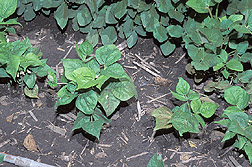 Following ozone exposure, the sensitive snap bean plant on the right is stunted and has some damaged leaves. The plant on the left, however, is more tolerant. ARS scientists are searching for bean genes that can use vitamin C to defend against ozone. (K10054-2) |
Scientists found that grasslands were actually substantial contributors to carbon storage. Soil in ecosystems represented by the Mandan site was storing 1 million metric tons of carbon each year; the Woodward site, 2 million; and the Temple site, 6 million. All eight other sites had similar findings. The effects of grazing and fire on carbon storage are now under study at many of the sites. Albert B. Frank, an ARS plant physiologist at Mandan, says he has found that properly grazed lands can store as much carbon as lands that are never grazed. But overgrazing can cause loss of the carbon stored in soil. Woodward researchers are working to find the rate of grazing that optimizes animal production and rangeland health. Each of the 11 monitoring sites has at least one 6- to 8-foot tower to measure CO2 exchange among plants, soil, and atmosphere. Each tower has a CO2 Bowen ratio station—a type of weather station equipped with instruments that take more than 30 measurements, including CO2 and water vapor gradients. The samplers take readings every 2 seconds and calculate an average CO2 gradient every 20 minutes, around the clock. Four of the sites also have closed, 1-meter-square chambers for comparing CO2 uptake at the soil level with information from the CO2 station. |
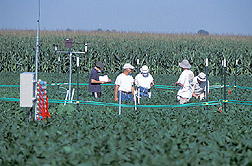 ARS scientists from Urbana and Phoenix join forces in Urbana, Illinois, to measure the effects of elevated ozone on soybean photosynthesis, growth, and development. (K10052-1) |
The network represents the ecosystems that make up America's western rangelands, as well as many ecosystems around the world. The other sites are at Burns, Oregon; Logan, Utah; Dubois, Idaho; Miles City, Montana; Cheyenne, Wyoming; Fort Collins, Colorado; Tucson, Arizona; and Las Cruces, New Mexico. Boise, Idaho, entered the network in mid 2002. About FACE In addition to monitoring the exchange of CO2 between the atmosphere and the land, ARS and other scientists are studying the effects of elevated levels of CO2 on crop plants. One such scientist is Donald R. Ort, a plant physiologist who leads ARS' Photosynthetic Research Unit in Urbana, Illinois. In soybean fields not far from Urbana, Ort hopes to harvest a wealth of information from the plants that could foretell how this important legume crop would perform under elevated levels of CO2 and ozone predicted for the middle of this century, he says. |
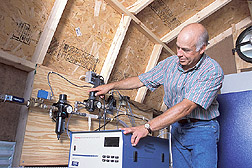 Plant physiologist Donald Ort monitors output of an ozone generator. (K10049-1) |
To do this, Ort and colleagues at ARS and the University of Illinois at Urbana-Champaign (U of I) have encircled portions of the 40-acre field with ringlike devices that fumigate the plants with 550 parts per million (ppm) of CO2 and up to 150 parts per billion (ppb) of ozone. In the Urbana study, the concentration of CO2 is about 1.5 times more than the current level of 370 ppm, and ozone levels are about 1.5 times the current ambient levels of 40-50 ppb in the Midwest. At ground level, ozone is an air pollutant that is toxic to plants. It is created when photochemical reactions involving gases from industrial and transportation sources occur in the presence of sunlight. When crops such as soybeans are grown in ozone concentrations typical in some regions of the country, photosynthesis can be suppressed, which lowers yields. Ground-level concentrations of ozone, like those of CO2, are increasing. The long-term goal of the 10-year project, called SoyFACE, is to make sure the nation's soybean farmers are well stocked with new varieties of the crop that can tolerate higher ozone, take advantage of the increased CO2, or both. |
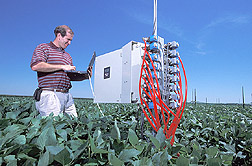 University of Illinois site manager and engineer Tim Meis programs CO2 and ozone level controls for the distribution station just outside of each CO2 and ozone FACE ring. (K10048-1) |
"If we wait for global climate change to happen, we're going to be way behind the curve," says Ort. He, along with Stephen Long, a professor at U of I's Department of Crop Science, lead the study—now in its second year—in close collaboration with about 14 other research teams. Ort's lab monitors changes in leaf transpiration rates, photosynthetic capacity, and other biological activities of test plants as they're fumigated with CO2, different concentrations of ozone, or both. All the while, scientists compare the data they glean from the test plants to data from control plants. Of particular interest are soybean lines whose seed yields seem to rise in response to elevated CO2. "There are reports that certain soybean cultivars and parentages can take advantage of elevated CO2," says Ort. "Others may adjust to it by slowing their photosynthetic activity." Use of the fumigation rings also affords an opportunity to explore the prediction that higher CO2 may help abate ozone damage to plants. One reason may be that the leaf openings, called stomata, constrict at elevated CO2 levels, so ozone is less able to enter and cause harm at the cellular level. |
|
|
Also showing their stamina are new snap beans developed by the ARS Air Quality Plant Growth and Development Research Unit, in Raleigh, North Carolina. These beans show high resistance to foliage damage under the heightened ozone conditions of the fumigation rings, whereas sensitive lines show extensive injury. Plant physiologist Kent Burkey is looking for genes associated with the snap beans' ability to use their own vitamin C to defend against ozone. Next, researchers will begin the search for genetic traits and markers. Bean breeders can one day use these to speed development of new tolerant varieties. SoyFACE follows earlier Free Air CO2 Enrichment (FACE) experiments conducted by ARS researcher Bruce A. Kimball and others, near Phoenix. The Arizona group has studied cotton, wheat, and sorghum. In the late 1980s, researchers from Brookhaven National Laboratory working with Kimball and other ARS and university scientists developed the FACE technology. Now there are more than a dozen FACE projects in the United States and around the world. Using FACE technology, scientists release large quantities of CO2 over plots of open-field crops, thereby simulating conditions as representative of future fields as is possible today. Researchers found that crops that use the type of photosynthesis called C3, such as wheat, rice, and cotton, all increased in yield with elevated levels of CO2. Cotton's yield increased by 40 percent when CO2 was added. Wheat yield increased about 15 percent, and the plants used about 7 percent less water. Yields of sorghum, a crop that uses C4-type photosynthesis, did not increase with an additional 200 ppm of CO2 at ample water supply, but the plants used about 10 percent less water. On the other hand, under drought conditions, grain yields increased 25 percent on average. The initial FACE studies were a great success, providing much of the information available on how crops would likely respond to changes in their environment. Increased Temperatures Have a Chilling Effect Research at ARS' Crop Genetics and Environmental Research Unit in Gainesville, Florida, indicates that global warming could be more of a problem for seed crops than for forage crops. L. Hartwell Allen, Jr., an ARS soil scientist, says the threat to crops such as cereal grains and legumes isn't rising CO2, but rather a potential rise in temperatures. While higher CO2 levels tend to increase crop yields, elevated temperatures could leave seed crops sterile. In elevated-temperature studies, either pollination of individual flowers fails completely or, when fertilization is successful, seeds develop poorly. For example, soybean yields are reduced both because fewer seeds are produced and individual grains weigh less. As a rule of thumb, Allen says, seed productivity decreases about 10 percent for every 2 degrees Fahrenheit the temperature increases above ideal levels. But photosynthesis and plant size are little affected until much higher temperature levels. Even when seed development fails in a plant, it may still grow to its typical size. Allen, plant physiologist Joseph Vu, and University of Florida crop physiologist Kenneth Boote found that several physiological functions related to reproduction and pollination fail as temperatures increase. Abnormally high temperatures during the short pollination season (2 to 3 weeks) could affect seed development at exactly the wrong time in a plant's life cycle. Traditional breeding could offer the best hope if, for example, scientists locate wild relatives that grow in very hot environments and incorporate their tolerance into productive crop varieties. Allen says the time of day when pollen is shed in a plant could be a factor in its survival. Varieties that shed pollen earlier in the day, when temperatures are cooler, would be more likely to flourish. Genetic engineering could help if scientists introduce desirable genes from other plants. Although increased CO2 levels appear to benefit many plants, it is the interaction of multiple environmental factors that makes predicting the effects of global change on agriculture challenging. Fortunately, agricultural soils also store carbon, where it provides environmental and productivity benefits and helps to alleviate atmospheric CO2 levels.—By David Elstein, Don Comis, Jan Suszkiw, and Jim Core, Agricultural Research Service Information Staff. This research is part of Global Change, an ARS National Program (#204) described on the World Wide Web at http://www.nps.ars.usda.gov. Albert B. Frank is in the USDA-ARS Natural Resource Management Research Unit, Northern Great Plains Research Laboratory, P.O. Box 459, Mandan, ND 58554-0459; phone (701) 667-3007, fax (701) 667-3054. Donald R. Ort is in the USDA-ARS Photosynthesis Research Unit, 1201 W. Gregory Dr., Urbana, IL 61801-3838; phone (217) 333-2093, fax (217) 244-0656. Bruce A. Kimball is with the USDA-ARS Water Conservation Laboratory, 4331 East Broadway Rd., Phoenix, AZ 85040-8807; phone (602) 437-1702, fax (602) 437-5291. L. Hartwell Allen, Jr., is in the USDA-ARS Crop Genetics and Environmental Research Unit, CMAVE, 1700 SW 23rd Drive, Gainesville, FL 32608; phone (352) 392-8194, fax (352) 392-6139. |
|
"Leading the Way in CO2 Research" was published in the October 2002 issue of Agricultural Research magazine. |







